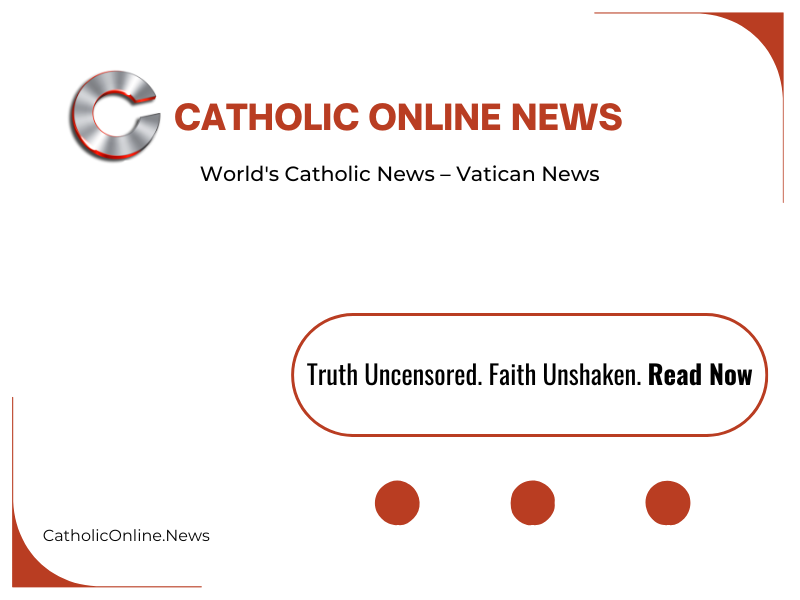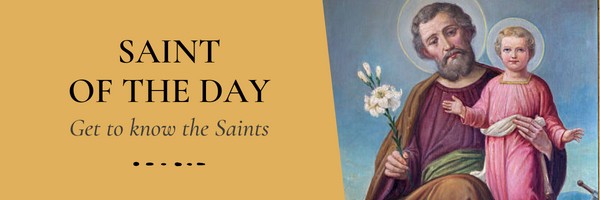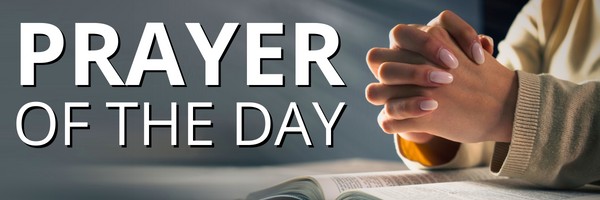 Dear readers, Catholic Online was de-platformed by Shopify for our pro-life beliefs. They shut down our Catholic Online, Catholic Online School, Prayer Candles, and Catholic Online Learning Resources essential faith tools serving over 1.4 million students and millions of families worldwide. Our founders, now in their 70's, just gave their entire life savings to protect this mission. But fewer than 2% of readers donate. If everyone gave just $5, the cost of a coffee, we could rebuild stronger and keep Catholic education free for all. Stand with us in faith. Thank you. Help Now >
Dear readers, Catholic Online was de-platformed by Shopify for our pro-life beliefs. They shut down our Catholic Online, Catholic Online School, Prayer Candles, and Catholic Online Learning Resources essential faith tools serving over 1.4 million students and millions of families worldwide. Our founders, now in their 70's, just gave their entire life savings to protect this mission. But fewer than 2% of readers donate. If everyone gave just $5, the cost of a coffee, we could rebuild stronger and keep Catholic education free for all. Stand with us in faith. Thank you. Help Now >
Felix Martin
FREE Catholic Classes
Antiquary, historiographer, architect, educationist, b. 4 October, 1804, at Auray, seat of the famous shrine of St. Ann in Brittany, France ; d. at Vaugirard, Paris, 25 November, 1886. His father, Jacques Augustin Martin, for many years mayor of Auray and Attorney-General of Morbihan, was a public benefactor. His mother was Anne Arnel Lauzer de Kerzo, a truly pious matron, of whose ten children three entered religious comunities, while the others, as heads of families, shone in Breton society as models of every domestic virtue. Felix, having made his classical studies at the Jesuit seminary close by the shrine of St. Anne, entered the Society of Jesus at Montrouge, Paris, 27 September, 1823, but on the opening of a new novitiate at Avignon, in Aug., 1824, he was transferred there. Thence in 1826 he was sent to the one time famous college of Arc, at Dôle, to complete his logic and gain his first experience in the management of youth among its 400 pupils. The following scholastic year, 1826-1827, at St-Acheul, he began his career as teacher. This was soon to be interrupted, for already among the revolutionists of the boulevards and in the Chamber of Deputies, the wildest and most preposterous accusations had been formulated against the Society. This agitation culminated on 16 June, 1828, in the "Ordonnances de Charles X" which were to be enforced the following October. The Fathers, meanwhile, quietly closed their colleges, their teachers went into temporary exile and among them Fr. Martin. He spent the succeeding years in colleges established across the frontier.
In Switzerland, Brieg and Estavayé; in Spain, Le Passage near St. Sebastian ; in Belgium, the College of Brugelette, were in turn the scenes of his labours as student or as teacher. It was when he was in Switzerland, in 1831, that he received Holy orders. Eleven years later, while engaged in the ministry at Angers he was informed that, under Father Chazelle, ex-rector of St. Mary's College, Kentucky, he was chosen together with Fathers Hainpaux, Tellier and Dominique du Ranquet to restore the Society of Jesus in Canada, extinct since the death of Father Jean Joseph Casot at Quebec on 16 March, 1842. On 2 July, Mgr. Bourget, at whose invitation the fathers had come, confided to them the parish of Laprairie, deprived of its pastor, the Rev. Michael Power, by his promotion to the newly erected episcopal see of Toronto, 26 June, 1842. On 31 July, 1844, Fr. Martin was named superior of the mission in Lower Canada, now the Province of Quebec. The enthusiastic citizens of Montreal had generously subscribed towards the building of a college, his principal preoccupation. In May, 1847, ground was broken and the foundations were laid. Then came a series of disasters which interrupted all further work. The greater portion of Laprairie was swept by fire and the presbytery of the fathers was reduced to ashes. The great conflagration of Quebec followed, whereby a vast portion of the city was destroyed. Thousands of Irish immigrants were pouring into the country; in 1847 the numbers reached nearly 100,000. With them they brought the dreaded typhus or ship-fever. In that year alone nearly two thousand were stricken down in Montreal. With Christian intrepidity the priests of St. Sulpice, pastors of the city, devoted themselves to the spiritual relief of the sick and dying, and five at the outset fell victims to their zeal. Fathers Paul Mignard and Henri du Ranquet, arriving from New York gave timely assistance. But this was far from sufficient, so Fr. Martin appealed to Fr. Thébaud, rector of St. John's, Fordham, for volunteers to assist the plague-stricken. The answer was the immediate arrival of Fathers Driscoll, Dumerle, Ferard and Schianski. All escaped the contagion except Fr. Dumerle, who fell a martyr of charity.
The priests of St. Sulpice, whose ranks were thinned by the ravages of the plague, asked for four English-speaking Fathers to take charge of St. Patrick's Church. A presbytery was provided for them near the very ground whereon the college had been commenced. In it there was room sufficient to house a few teachers. A temporary structure was put up, and opened as a college on 20 September, 1848. A few boarders even were received and lodged in a small tenement in a street hard by. It was not till the month of May, 1850, that work was resumed on the college building, but so strenuously was it prosecuted that Mgr Bourget was invited to bless it, in its advanced stage of completion, on 31 July, 1851, feast of St. Ignatius. On 4 August the novitiate was transferred from its temporary quarters in M. Rodier's house, and installed in the new edifice, and in the beginning of September everything was in perfect working order in the young institution of learning, from under whose roof, in later years, so many remarkable men were to go forth as statesmen, judges, physicians and members of the clergy and of the bar. This was Fr. Martin's achievement. But he was not only the founder of St. Mary's College, the financier, the architect, and the overseer of the material construction, he was also the systematizer of its curriculum during his rectorship which lasted until 1857. The stately pile of St. Patrick's Church, Montreal, was also of his designing, the main outlines of which are in pure thirteenth-century Gothic. Fr. Martin was the originator of the well-known Archives of St. Mary's College , and the principal collector of the records of an almost forgotten past. With such men as Viger, Faribault, E. G. O'Callaghan, etc., he quickened, if he really did not set on foot, that campaign of research which ended in the placing within reach of all the original historical sources of the colonial and missionary days of New France.
No better account of Fr. Martin's labours in this field could be given than that which appeared a few months after his death in the "Catholic World" (N. Y., April, 1887): "But, it is, perhaps, as an antiquarian and a man of letters that Fr. Martin has become most generally known. His services to historical literature, particularly the history of Canada, have been many and great. He devoted himself amidst all his onerous duties to the task of throwing light on the dark places of the past. He was commissioned by Government to explore the regions where of old the Jesuits had toiled amongst the Hurons, giving at last to the dusky tribes the priceless gifts of faith. He wrote at this time a work embellished with various plans and drawings, all of which remained in possession of the Government. He also collected many curious Indian relics. In 1857 he was sent by the Canadian Government to Europe on a scientific mission, and was likewise entrusted with the task of examining the Archives of Rome and of Paris for points of interest in relation to Canadian history. In this he was eminently successful. He discovered a number of unpublished documents relating to Canada which would be sufficient to fill a folio volume. Perhaps his most eminent service to historical literature was his great share in bringing out the 'Relations des Jésuites' [1611-1672], a very mine of information for the scholar.… He discovered and put into print, with preface and most valuable annotations by himself, the 'Relations' extending from 1672 to 1679. He added to them two geographical charts.… Fr. Martin also translated from Italian to French the 'Relation' of Père Bressani, which he published with notes, together with a biography of that glorious martyr. His historical works included Lives of Samuel de Champlain (?), the founder of Quebec, of Fathers Brébeuf, Chaumonot and Jogues [and, not mentioned in the article, of Montcalm]. The latter [that of Fr. Jogues] has become known to the American public through the translation made by our foremost Catholic historian, John Gilmary Shea. Fr. Martin was the friend, adviser, and co-labourer of the eminent Canadian historical writer, J. Viger." And letters preserved in the College archives attest that his relations with E. B. O'Callaghan, compiler of the "Documentary History of New York", were of a kindred nature.
Among his lesser publications may be mentioned: "Notice Biographique de la Mère S. Stanislas [his sister] Religieuse de la Misericorde de Jésus, de la Hôtel-Dieu d'Auray, 1886", "Manuel du Pélerin à N. D. de Bonsecours", "Neuvaine à St. François Xavier" and "Neuvaine à St. Antoine de Padoue". After his return from Europe, in 1858 and 1859, he was bursar of St. Mary's College, and the two following years, 1860 and 1861, superior of the Quebec residence. His eyesight was already much impaired, and the glare of the Canadian snows was very trying, so much so that he was threatened with total blindness. For this reason he was recalled to France. He spent part of the year 1862 at Ste Geneviève College, Paris, and was appointed on the 12 September (1862) rector of the college of Vannes.
After three years, on 8 Sept., 1865, he was named superior of the residence of the Holy Name at Poitiers. Thence he was transferred to Vaugirard College at Paris, where he had the spiritual direction of the house for six years. On 5 Sept., 1874, he went to Rouen for three years as superior, and returned to Vaugirard in 1878. At the closing of the Jesuit colleges by the arbitrary enactments of the French Republic, the community of Vaugirard was dispersed, and Fr. Martin, with a few others of his fellow religious took up their abode in 1882 at No. 1 Rue Desnouettes. Here he remained for five years patiently awaiting the final call of the Master, though never ceasing to collect materials bearing on the history of the country of his predilection. Physically, Fr. Martin was of medium height, heavily built, but carrying his weight lightly and with dignity. His name is a household word for all who are given to historical research not only in Canada of today but throughout the vast territory comprised within the vaguely defined limits of New France .
Join the Movement
When you sign up below, you don't just join an email list - you're joining an entire movement for Free world class Catholic education.
An Urgent Message from Sister Sara – Please Watch
- Advent / Christmas
- 7 Morning Prayers
- Mysteries of the Rosary
- Litany of the Bl. Virgin Mary
- Popular Saints
- Popular Prayers
- Female Saints
- Saint Feast Days by Month
- Stations of the Cross
- St. Francis of Assisi
- St. Michael the Archangel
- The Apostles' Creed
- Unfailing Prayer to St. Anthony
- Pray the Rosary
![]()
Copyright 2025 Catholic Online. All materials contained on this site, whether written, audible or visual are the exclusive property of Catholic Online and are protected under U.S. and International copyright laws, © Copyright 2025 Catholic Online. Any unauthorized use, without prior written consent of Catholic Online is strictly forbidden and prohibited.
Catholic Online is a Project of Your Catholic Voice Foundation, a Not-for-Profit Corporation. Your Catholic Voice Foundation has been granted a recognition of tax exemption under Section 501(c)(3) of the Internal Revenue Code. Federal Tax Identification Number: 81-0596847. Your gift is tax-deductible as allowed by law.









